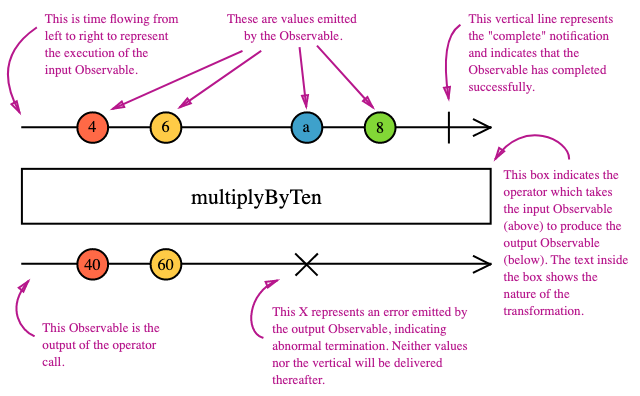Rxjs
Overview
The essential concepts in RxJS which solve async event management are:
- Observable: represents the idea of an invokable collection of future values or events.
- Observer
- Subscription: represents the execution of an Observable, is primarily useful for cancelling the execution.
- Operators: are pure functions that enable a functional programming style of dealing with collections with operations like map, filter, concat, flatMap, etc.
- Subject: is the equivalent to an EventEmitter, and the only way of multicasting a value or event to multiple Observers.
- Schedulers: are centralized dispatchers to control concurrency, allowing us to coordinate when computation happens on e.g. setTimeout or requestAnimationFrame or others.
RxJS introduces Observables, a new Push system for JavaScript. An Observable is a Producer of multiple values, "pushing" them to Observers (Consumers).
- A Function is a lazily evaluated computation that synchronously returns a single value on invocation.
- A generator is a lazily evaluated computation that synchronously returns zero to (potentially) infinite values on iteration.
- A Promise is a computation that may (or may not) eventually return a single value.
- An Observable is a lazily evaluated computation that can synchronously or asynchronously return zero to (potentially) infinite values from the time it's invoked onwards.
"Think of RxJS as Lodash for events."
Because RxJS centers around this concept of function purity. Normally, we create impure functions which leave our state exposed, making it more prone to errors from other pieces of code.
- ex. if we have a variable
countand increment it each time a button is clicked, there is nothing stopping some other piece of code mutating that value itself.- alternatively, with observables, we can just create an observable out of the event (
fromEvent)
- alternatively, with observables, we can just create an observable out of the event (
Marble diagram:

Observers
An observer is a collection of 3 callbacks that knows how to listen to values (ie. types of notification) delivered by the Observable.
- those types of notification are:
- the observer got the next value
- the observer got the last value
- the observer got an error
An observer may be partial
Example: event listeners
Normally we register event listeners by finding an HTML element and calling addEventListener on it. With RxJS, we can create an observable that represents a stream of events.
- ex. we can attach an observable to a
<button />element. We can then configure observers tosubscribeto this observable, and will be notified any time the button is clicked:
var button = document.querySelector('button');
Rx.Observable.fromEvent(button, 'click')
.subscribe(() => console.log('Clicked!'));
Questions
- what is meant by inner/outer observable
Resources
Children
Backlinks